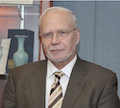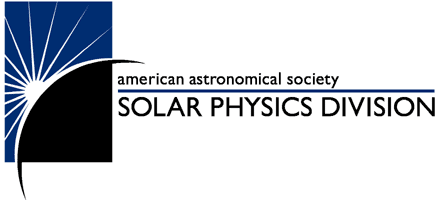Previous winners of the George Ellery Hale Prize
More citations will be added as they become available. Any member who has
the text of earlier Hale prize citations is encouraged to contact the
Division Secretary.
Eugene N. Parker, 1978
The first Hale Prize was awarded to Eugene Parker at the Madison
meeting in June 1978, for his "imaginative and stimulating
contributions in which plasma and magntohydrodynamical physics
have been applied to astronomy."
Parker delivered the Hale Prize lecture at the joint AAS/SPD
meeting in Wellesley in 1979.
ASP Bruce Medal, 1997
John P. Wild, 1980
John W. Evans, 1982
Leo Goldberg, 1984
Peter A. Sturrock, 1986
Cornelis de Jager, 1988
Richard N. Tousey, 1990
Horace W. Babcock, 1992
ASP Bruce Medal, 1969
Douglas O. Gough, 1994
The 1995 Hale Prize is to be awarded to Professor Douglas Gough
of the University of Cambridge. Gough has contributed with distinction
to many aspects of solar physics, astrophysics and fluid dynamics,
including nonlinear convection in stars, the coupling of turbulent
convection to pulsations, and stellar structure.
Gough's theoretical inquiry has often combined fluid theory and the
detailed physics of stellar structure, as when he showed that the core
of the sun is unstable to gravity modes. This instability may lead to
episodes of mixing, casting some doubt on standard quiescent models.
In recent years, Gough has devoted most of his attention to helioseismology,
to which he has made many notable contributions. He has led the way
in applying inversion techniques to infer the internal structure and the
distribution of angular velocity in the interior, and was the first to use
helioseismic data to determine the depth of the convection zone. He has
also used helioseismic data to investigate solar opacities, the equation
of state, the helium abundance, and the neutrino problem.
Gough has also played a significant role in the development of the
GONG project, the helioseismological experiments on SoHO, and observational
programs in asteroseismology.
Raymond Davis, 1996
In recognition of his monumental contribution to solar physics by
conceiving, planning, constructing, operating, and analyzing data from, an
experiment to measure the solar neutrino flux
AAS Tinsley Prize, 1994;
Nobel Prize, 2002
Richard B. Dunn, 1998
For his bold and imaginative innovation of instrumentation for solar
physics, his discovery of important new phenomena on the Sun, and the impact
of his contributions on solar physicists world wide.
John W. Harvey, 1999
The 1999 Hale Prize is awarded to John W. Harvey for his fundamental
contributions to our understanding of the nature of solar magnetic fields
and of the internal structure of the Sun through helioseismology, for his
development of innovative solar instrumentation, and for his selfless and
untiring service to the solar physics community.
Loren W. Acton, 2000
The 2000 Hale Prize is awarded to Loren Acton for his pioneering,
instrumental, and analytical work in soft x-ray observations of the active
sun and for his unstinting, active, and helpful support of research and
researchers in this and other areas of solar physics.
Alan M. Title, 2001
The 2001 Hale Prize is awarded to Alan Title for his exceptional leadership
in developing multiple, innovative, high resolution telescopes and
interpreting their data to dramatically advance our understanding of the sun
and for his generous public service on behalf of the solar and
solar-terrestrial communities.
Eric R. Priest, 2002
The Hale Prize for 2002 is awarded to Eric Priest for his seminal
contributions to investigations of the role of the magnetic field in solar
activity, and for his tireless advocacy of solar physics in all corners of
the world.
Eric Priest's Hale Prize lecture (HTML format)
Photos from the Hale Prize ceremony on June 6, 2002.
Robert F. Howard, 2003
The 2003 Hale Prize is awarded to Robert F. Howard for his
pioneering discoveries of fundamental properties of
solar magnetic and velocity fields;
initiating modern instrumentation and archiving methods for
long-term solar observations;
and selfless mentoring, collaboration, and leadership of
solar physics research programs and institutions.
Robert P. Lin, 2004
The 2004 Hale Prize is awarded to Robert Lin for pioneering experimental work
on the detection of high energy solar radiation and particles,
for his many discoveries in the field of high energy solar and heliospheric
physics and for his generous and untiring leadership of, and support for,
research programs and projects in this field.
Spiro Antiochos, 2005
The 2005 Hale Prize is awarded to Spiro Antiochos for his work on the
thermodynamics and stability of coronal magnetic fields and for his
outstanding public service to the solar research community.
Spiro Antiochos' Hale Prize lecture
(tar gzipped: 87 Mbytes, uncompresses to over 200 Mbytes)
Peter A. Gilman, 2006
The 2006 Hale Prize is awarded to Peter A. Gilman for his unique
insights and substantial scientific achievements in understanding the
dynamics of the solar convection zone and the mechanism of the Sun's
magnetic dynamo and for his leadership and support of solar physics
research programs.
Peter Gilman's Hale Prize lecture and animations
Mukul Kundu, 2007
The 2007 Hale Prize is awarded to Mukul R. Kundu for his many outstanding
contributions to the field of solar radio astronomy and for his service
to the solar community in the U.S. and abroad.
![[Thumbnail image of Hale Prize winner Hugh S. Hudson]](images/prize_winners/hudson_tn.gif) Hugh Hudson, 2008
Hugh Hudson, 2008
The 2008 Hale Prize is awarded to Hugh S. Hudson for his fundamental contributions
to many aspect of solar and heliospheric physics, in particular his studies of magnetic
reconnection and particle acceleration in solar flares, the initiation of coronal mass
ejections, nanoflare coronal heating, and the variability of the solar irradiance.
He is also recognized for his leadership and contributions to the solar physics
community, especially his untiring support for international research collaborations.
![[Thumbnail image of Hale Prize winner Neil R. Sheeley, Jr.]](images/prize_winners/sheeley_tn.gif) Neil Sheeley, 2009
Neil Sheeley, 2009
The 2009 Hale Prize is awarded to Neil R. Sheeley, Jr., for his continuing outstanding contributions
to our understanding of the solar magnetic field, coronal holes, and coronal mass ejections. His
wide-ranging observational and theoretical work has laid the foundation for much current research
in solar and heliospheric physics, and continues to have important applications in space weather prediction.
Neil Sheeley's Hale Prize lecture and animations
![[Thumbnail image of Hale Prize winner Marcia Neugebauer]](images/prize_winners/neugebauer_tn.gif) Marcia Neugebauer, 2010
Marcia Neugebauer, 2010
The 2010 Hale Prize is awarded to Marcia Neugebauer, for her seminal contributions to the discovery
of the solar wind and her extensive and ongoing contributions to solar-heliospheric physics.
Marcia Neugebauer's Hale Prize lecture
![[Thumbnail image of Hale Prize winner Henk Spruit]](images/prize_winners/spruit_tn.gif) Henk Spruit, 2011
Henk Spruit, 2011
The 2011 Hale Prize is awarded to Henk Spruit, for insightful and pioneering work on the structure
of magnetic flux tubes and sunspots and on their interaction with the flow of energy in the solar
convection zone.
Henk Spruit's Hale Prize lecture
![[Thumbnail image of Hale Prize winner Don Reames]](images/prize_winners/reames_tn.gif) Don Reames, 2012
Don Reames, 2012
In recognition of his pioneering work on the composition and transport of Solar Energetic Particles, and for the key insights
that firmly established the modern paradigm for SEP production, the 2012 Hale Prize is awarded to Don Reames of the NASA
Goddard Space Flight Center.
Don Reames's Hale Prize Lecture
![[Thumbnail image of Hale Prize winner Dick Canfield]](images/prize_winners/canfield_tn.gif) Dick Canfield, 2013
Dick Canfield, 2013
The 2013 Hale Prize is awarded to Richard Canfield for his pioneering work on dynamics and radiation in solar flares and
on the origins and implications of magnetic helicity in active regions, as well as his role as a leader and mentor.
Dick Canfield's Hale Prize Lecture
![[Thumbnail image of Hale Prize winner Tom Duvall, Image Copyright Joson Images]](images/prize_winners/duvall_tn.jpg) Thomas Duvall, Jr., 2014
Thomas Duvall, Jr., 2014
The 2014 Hale Prize is awarded to Thomas Duvall. Jr. for his invention and application of innovative helioseismic methods
and the resulting ground-breaking discoveries within the solar interior, including internal sound-speed and rotation profiles,
meridional circulation, wave perturbations in sunspots, and large scale convection properties.
 George Doschek, 2015
George Doschek, 2015
The 2015 Hale Prize is awarded to George Doschek for his pioneering work in solar spectroscopy,
in particular for his important insights into the interpretation and analysis of solar spectral
observations, and his leadership as US principal investigator of the Yohkoh Bragg Crystal
Spectrometer and Hinode Extreme Ultraviolet Imaging Spectrometer instruments.
 Terry Forbes, 2016
Terry Forbes, 2016
The 2016 George Ellery Hale Prize for outstanding contributions to the field of solar astronomy is awarded to Terry G. Forbes
(University of New Hampshire) for his significant contributions to the theory of magnetic reconnection, for his development
of important new models of the physics of solar flares and coronal mass ejections, and for his achievements mentoring
students and junior scientists in the solar physics community.
Terry Forbes's Hale Prize Lecture




![[Thumbnail image of Hale Prize winner Hugh S. Hudson]](images/prize_winners/hudson_tn.gif) Hugh Hudson, 2008
Hugh Hudson, 2008![[Thumbnail image of Hale Prize winner Neil R. Sheeley, Jr.]](images/prize_winners/sheeley_tn.gif) Neil Sheeley, 2009
Neil Sheeley, 2009![[Thumbnail image of Hale Prize winner Marcia Neugebauer]](images/prize_winners/neugebauer_tn.gif) Marcia Neugebauer, 2010
Marcia Neugebauer, 2010![[Thumbnail image of Hale Prize winner Henk Spruit]](images/prize_winners/spruit_tn.gif) Henk Spruit, 2011
Henk Spruit, 2011![[Thumbnail image of Hale Prize winner Don Reames]](images/prize_winners/reames_tn.gif) Don Reames, 2012
Don Reames, 2012![[Thumbnail image of Hale Prize winner Dick Canfield]](images/prize_winners/canfield_tn.gif) Dick Canfield, 2013
Dick Canfield, 2013![[Thumbnail image of Hale Prize winner Tom Duvall, Image Copyright Joson Images]](images/prize_winners/duvall_tn.jpg) Thomas Duvall, Jr., 2014
Thomas Duvall, Jr., 2014 George Doschek, 2015
George Doschek, 2015 Terry Forbes, 2016
Terry Forbes, 2016